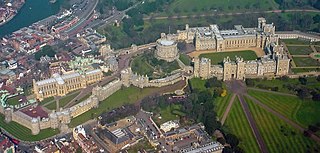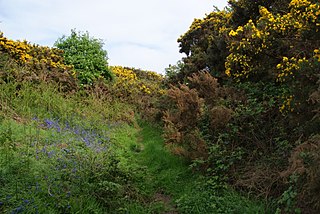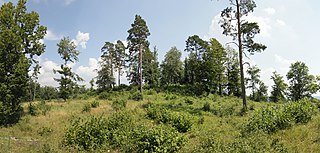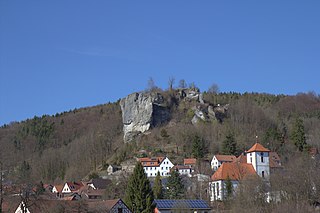External links
- "Unterleinleiter". Alle Burgen (in German).
| | This article about a castle in Germany is a stub. You can help Wikipedia by expanding it. |
| Unterleinleiter Castle | |
|---|---|
| Unterleinleiter | |
| Type | lowland castle, motte and bailey? |
| Code | DE-BY |
| Height | Height missing, see template documentation |
| Site information | |
| Condition | lost or levelled |
| Site history | |
| Built | mentioned 1380 |
Unterleinleiter Castle (German : Burg Unterleinleiter) is a now-levelled, medieval lowland castle near the village of Unterleinleiter in the county of Forchheim in the south German state of Bavaria.
Walter VI of Streitberg is mentioned as the occupant castle referred to in 1380 as Leinlewter Fortress and which was destroyed in 1409 due to a breach of the Landfrieden .
Of the former fortification, which could have been a motte and bailey castle, nothing has survived. In 1536 the site was still described as Wale, i.e. a motte.

Cadzow Castle, now in ruins, was constructed between 1500 and 1550 at a site one mile south-east of the centre of Hamilton, South Lanarkshire, Scotland. The earlier medieval settlement of Hamilton was formerly known as Cadzow or Cadyou, until it was renamed in 1455 in honour of James Hamilton, 1st Lord Hamilton. The castle sits above a gorge overlooking the Avon Water in what is now Chatelherault Country Park, but was previously the hunting and pleasure grounds of the duke of Hamilton's estate of Hamilton Palace - this area being known as Hamilton High Parks. The ruin is a Scheduled Ancient Monument.

A motte-and-bailey castle is a European fortification with a wooden or stone keep situated on a raised area of ground called a motte, accompanied by a walled courtyard, or bailey, surrounded by a protective ditch and palisade. Relatively easy to build with unskilled labour, but still militarily formidable, these castles were built across northern Europe from the 10th century onwards, spreading from Normandy and Anjou in France, into the Holy Roman Empire, as well as the Low Countries it controlled, in the 11th century, when these castles were popularized in the area that became the Netherlands. The Normans introduced the design into England and Wales. Motte-and-bailey castles were adopted in Scotland, Ireland, and Denmark in the 12th and 13th centuries. By the end of the 13th century, the design was largely superseded by alternative forms of fortification, but the earthworks remain a prominent feature in many countries.

A keep is a type of fortified tower built within castles during the Middle Ages by European nobility. Scholars have debated the scope of the word keep, but usually consider it to refer to large towers in castles that were fortified residences, used as a refuge of last resort should the rest of the castle fall to an adversary. The first keeps were made of timber and formed a key part of the motte-and-bailey castles that emerged in Normandy and Anjou during the 10th century; the design spread to England, Portugal, south Italy and Sicily. As a result of the Norman invasion of 1066, use spread into Wales during the second half of the 11th century and into Ireland in the 1170s. The Anglo-Normans and French rulers began to build stone keeps during the 10th and 11th centuries, including Norman keeps, with a square or rectangular design, and circular shell keeps. Stone keeps carried considerable political as well as military importance and could take a decade or more to build.

Stains is a commune in the Seine-Saint-Denis department, in the northern suburbs of Paris, France. It is located 11.6 km (7.2 mi) from the center of Paris.

Wiston Castle is a motte and bailey castle in the Pembrokeshire village of Wiston in south west Wales and is one of the best examples of its type in Wales. The castle and village were founded by Wizo, a Flemish settler who was granted the land by Henry I of England after he had wrested control from the previous owner, Arnulf de Montgomery. The castle was captured by the Welsh on several occasions but on each occasion it was retaken. It was abandoned during the thirteenth century when the then owner moved to nearby Picton Castle.

Bampton Castle in the parish of Bampton, Devon was the seat of the feudal barony of Bampton. It is located on a spur that overlooks the River Batherm.

Clifford Castle is a ruined castle in the village of Clifford which lies 2.5 miles to the north-east of Hay-on-Wye in the Wye Valley in Herefordshire, England. It was the caput of the feudal barony of Clifford, a Marcher Lordship. The castle stands in the grounds of a private house and is only open to the public on certain days of the year.

A shell keep is a style of medieval fortification, best described as a stone structure circling the top of a motte.
Events from the year 1181 in Ireland.

While there are many castles in South Yorkshire, the majority are manor houses and motte-and-bailey which were commonly found in England after the Norman Conquest.

A ringwork is a form of fortified defensive structure, usually circular or oval in shape. Ringworks are essentially motte-and-bailey castles without the motte. Defences were usually earthworks in the form of a ditch and bank surrounding the site.

Worcester Castle was a Norman fortification built between 1068 and 1069 in Worcester, England by Urse d'Abetot on behalf of William the Conqueror. The castle had a motte-and-bailey design and was located on the south side of the old Anglo-Saxon city, cutting into the grounds of Worcester Cathedral. Royal castles were owned by the king and maintained on his behalf by an appointed constable. At Worcester that role was passed down through the local Beauchamp family on a hereditary basis, giving them permanent control of the castle and considerable power within the city. The castle played an important part in the wars of the 12th and early 13th century, including the Anarchy and the First Barons' War.

Castell Gwallter, also known as Walter's Castle and sometimes Castell Penweddig, is the remains of a Norman motte-and-bailey castle situated on a large hill above the old village of Llandre in northern Ceredigion, Wales, four miles northeast of Aberystwyth.

Caernarfon Castle is a medieval fortress in Gwynedd, north-west Wales. The first fortification on the site was a motte-and-bailey castle built in the late 11th century, which King Edward I of England began to replace with the current stone structure in 1283. The castle and town established by Edward acted as the administrative centre of north Wales, and as a result the defences were built on a grand scale. There was a deliberate link with Caernarfon's Roman past—nearby is the Roman fort of Segontium—and the castle's walls are reminiscent of the Walls of Constantinople.
Burk Castle is a levelled medieval motte and bailey castle in the area known as Beim Schanzbach, about 550 metres south-southwest of the church in Burk, a village in the borough of Forchheim in the county of Forchheim in the south German state of Bavaria.
Niedermirsberg Castle, also called the Steinhaus, is a levelled motte castle which is situated 780 metres west of the village church of Niedermirsberg, in the borough of Ebermannstadt in the county of Forchheim in the south German state of Bavaria.
Kersbach Castle is a levelled medieval motte castle in the area of Pfarrgartenstraße 1 in the village of Kersbach, in the borough of Forchheim in the eponymous county in the south German state of Bavaria.

Ebermannstadt Castle is a levelled medieval motte castle on the heights of the Franconian Jura at Wacht Knock, west of the town of Ebermannstadt in the county of Forchheim in the south German state of Bavaria. It is one of the mightiest motte and bailey castles.

The ruins of Streitburg Castle (German: Burgruine Streitburg or Streitberg Castle are the remains of a high mediaeval aristocratic castle above the village of Streitberg, in the market borough of Wiesenttal in the Upper Franconian county of Forchheim in the German state of Bavaria. They lie directly opposite the ruins of Neideck Castle, the symbol of Franconian Switzerland, on the other side of the valley.
Bathgate Castle, near Bathgate, West Lothian, Scotland, was a motte-and-bailey castle. It was abandoned after 1327 and only the motte survives aside from some earthworks. It was designated a scheduled monument in 1961 by Historic Environment Scotland.